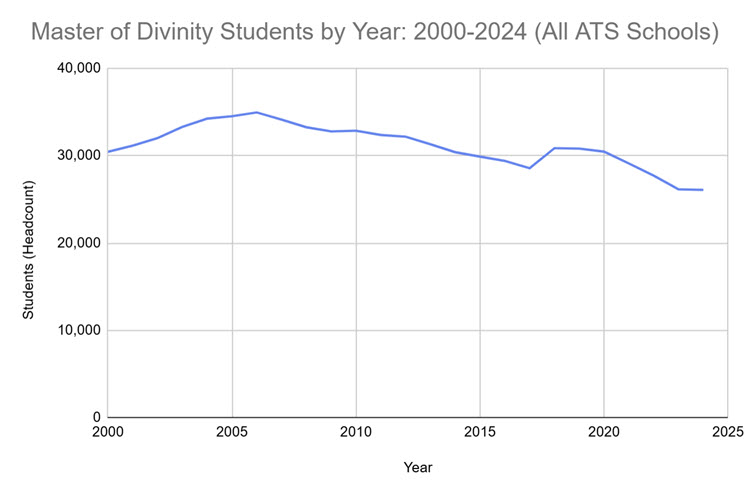In the years since I graduated from seminary with a Master of Divinity degree in 2001 much has changed. The overall landscape of theological education has shifted.
While the Master of Divinity degree remains the preferred pathway to ordination in Mainline Protestant denominations, it is increasingly possible for folks to chart paths to ordination without it. And, it is also now possible to complete one’s entire program (M.Div. or otherwise) online without ever stepping foot on a seminary campus (a topic I started writing about in 2011 with A Shift in Theological Education and Reshaping Seminary Education and continued to note the early expansion of in 2013 in A Progressive Seminary First).
Declining Enrollment
I often hear from lay church leaders that the seminaries are just not turning out anywhere near the number of Master of Divinity graduates as they used to nor as many as are needed. To better understand the actual shifts in enrollment I turned to the Association of Theological Schools to see what I might learn from their annual reporting. Using data found in each year’s Annual Data Tables, I constructed the chart below showing enrollment by year. More specifically I compared headcount enrollment (number of students) in Master of Divinity programs using Table 2.2 Headcount Enrollment, All Member Schools.

Less Radical
The actual decline is underwhelming.
The M.Div. headcount of 30,438 in 2000 declined to 26,082 in 2024, which is a decrease of 14%.
Other Options
The larger story here is not about how many students enroll, but rather what students who graduate go on to do. Increasingly those entering this course of study do not intend to serve in parish ministry, a point Kathryn Post makes in her recent Religion News Service article.
Post notes that seminaries are “increasingly welcoming students looking to discern their calling rather than intending to work at a congregation.” Additionally she highlights that while total enrollment in ATS schools is up 1.8% since 2020, M.Div. enrollment has declined by 14% over that same time period.
So What?
The opportunities for ongoing full-time employment in parish ministry look significantly different for new graduates today than they did when I graduated.
Helping long-time church leaders understand that shift is essential and provides the necessary context for the statistical reality of relative stability in M.Div. enrollment over the last twenty-five years. The total decline in headcount enrollment in Master of Divinity programs at ATS institutions from 2020 to 2024 was nearly identical to to that from 2000 to 2024 because enrollments in those two years were remarkably similar (2000: 30,438 compared to 2020: 30,455).